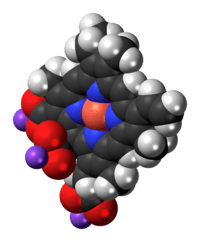Chlorophyllin
Chlorophyllin refers to any one of a group of closely related water-soluble salts that are semi-synthetic derivatives of chlorophyll, differing in the identity of the cations associated with the anion. Its most common form is a sodium/copper derivative used as a food additive and in alternative medicine. As a food coloring agent, copper complex chlorophyllin is known as natural green 3 and has the E number E141.[1]
 | |
 | |
| Names | |
|---|---|
| Other names
Natural green 3, E141 | |
| Identifiers | |
3D model (JSmol) |
|
| ChemSpider | |
| ECHA InfoCard | 100.031.117 |
PubChem CID |
|
| UNII | |
CompTox Dashboard (EPA) |
|
| |
| |
| Properties | |
| C34H31CuN4Na3O6 | |
| Molar mass | 724.159 g·mol−1 |
Except where otherwise noted, data are given for materials in their standard state (at 25 °C [77 °F], 100 kPa). | |
| Infobox references | |
Uses
Alternative medicine
Chlorophyllin is the active ingredient in a number of internally taken preparations intended to reduce odors associated with incontinence, colostomies, and similar procedures, as well as body odor in general. It is also available as a topical preparation, purportedly useful for both treatment and odor control of wounds, injuries, radiation burns, and other skin conditions."Chlorophyllin Uses, Side Effects & Warnings". Drugs.com. Retrieved 2020-03-29. Chlorophyllin has been used in alternative medicine as an aid to reduce the odor of urine or feces (bowel movements).
3D printing
Chlorophyllin has been used as a biocompatible photoblocker for generating green colored hydrogels with complex inner structures.[2]
Chemical properties
Chlorophyllin is water-soluble. In vitro, it binds to some environmental mutagens such as the polycyclic aromatic hydrocarbons benzo[a]pyrene[3] and dibenzo[a,i]pyrene.[4] Chlorophyllin also binds to acridine orange.[5]
References
- "Duranat Cu Chlorophyllin WSP (Natural Green 3-1 CI 75810-1)". Retrieved 15 October 2012.
- Benjamin, Aaron D.; Abbasi, Reha; Owens, Madison; Olsen, Robert J.; Walsh, Danica J.; Lefevre, Thomas B.; Wilking, James N. (2019). "Light-based 3D printing of hydrogels with high-resolution channels". Biomedical Physics & Engineering Express. 5 (2): 025035. doi:10.1088/2057-1976/aad667.
- Keshava C, Divi RL, Einem TL, Richardson DL, Leonard SL, Keshava N, Poirier MC, Weston A (2009). "Chlorophyllin significantly reduces benzo[a]pyrene-DNA adduct formation and alters cytochrome P450 1A1 and 1B1 expression and EROD activity in normal human mammary epithelial cells". Environmental and Molecular Mutagenesis. 50 (2): 134–144. doi:10.1002/em.20449. PMC 2637934. PMID 19152381.
- Castro DJ, Löhr CV, Fischer KA, Waters KM, Webb-Robertson BJ, Dashwood RH, Bailey GS, Williams DE (2009). "Identifying efficacious approaches to chemoprevention with chlorophyllin, purified chlorophylls and freeze-dried spinach in a mouse model of transplacental carcinogenesi". Carcinogenesis. 30 (2): 315–320. doi:10.1093/carcin/bgn280. PMC 2722150. PMID 19073876.
- Osowski A, Pietrzak M, Wieczorek Z, Wieczorek J (2010). "Natural compounds in the human diet and their ability to bind mutagens prevents DNA-mutagen intercalation". Journal of Toxicology and Environmental Health, Part A. 73 (17–18): 1141–1149. doi:10.1080/15287394.2010.491044. PMID 20706936.
External links
- Chlorophyll and Chlorophyllin, Linus Pauling Institute, Oregon State University
- 2002 Video from CNN
- Food-Info.net